
|
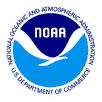
Cover/Title Page
Organizational Chart
Office of the Director
Office of Administration
and Research
Information and
Technology Services
Forecast Research
Division
Demonstration Division
Systems Development
Division
Aviation Division
Modernization Division
International Division
Publications
Acronyms and Terms
Figures Listing

Contact the Editor
Nita Fullerton
Web Design:
Will von Dauster
John Osborn
Best Viewed With
Internet Explorer
|

|
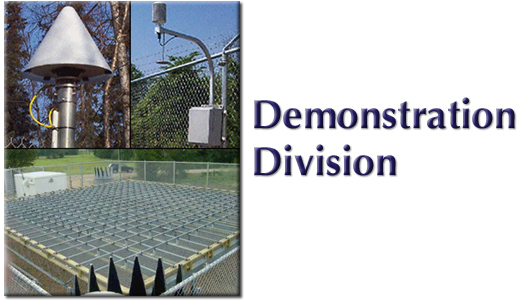 Margot H. Ackley, Chief
Margot H. Ackley, Chief
(Supervisory Physical Scientist)
(303-497-6791)
Web Homepage: http://www.profiler.noaa.gov
Norman L. Abshire, Electrical Engineer, 303-497-6179
Leon A. Benjamin, Programmer Analyst, 303-497-6031
Michael M. Bowden, Engineering Technician, 303-497-3260
James L. Budler, Engineering Technician, 303-497-7258
James D. Bussard, Information Systems Specialist, 303-497-6581
Michael A. Carrithers, Electronics Technician, 303-497-4376
Robert L. Cinea, Data Technician, 303-497-6200
Michael C. Foy, Systems Analyst, 303-497-4618
David J. Glaze, Electrical Engineer, 303-497-6801
Daphne M. Grant, PHASE Student, 303-497-5627
Seth I. Gutman, Physical Scientist, 303-497-7031
Kirk L. Holub, Systems Analyst, 303-497-6642
Bobby R. Kelley, Computer Specialist, 303-497-5635
Brian A. Koonsvitsky, Logistics Specialist, 303-497-3095
Michael J. Pando, Information Systems Specialist, 303-497-6220
Brian R. Phillips, Senior Engineering Technician, 303-497-6990
Alan E. Pihlak, Computer Specialist, 303-497-6022
Susan R. Sahm, Computer Specialist, 303-497-6795
Michael K. Shanahan, Electrical Engineer, 303-497-6547
Jebb Q. Stewart, Programmer Analyst, 303-497-6832
Scott W. Stierle, Systems Analyst, 303-497-6334
Richard G. Strauch, Electrical Engineer, 303-497-6385
Douglas W. van de Kamp, Meteorologist, 303-497-6309
David W. Wheeler, Electronic Technician, 303-497-6553
(The above roster, current when document is published, includes government,
cooperative agreement, and commercial affiliate staff.)
Address: NOAA Forecast Systems Laboratory – Mail Code: FS3
David Skaggs Research Center
325 Broadway
Boulder, Colorado 80305-3328
Objectives
The Demonstration Division evaluates promising new atmospheric observing technologies developed by the NOAA Research Laboratories and other
organizations and determines their value in the operational domain. Activities range from demonstrations of scientific and engineering innovations to
the management of new systems and technologies. In support of NOAA’s environmental assessment and prediction mission, the division uses new
upper-air observing techniques to create and disseminate reliable assessments of weather, climate, space environment, and geodetic phenomena.
The data and techniques developed and implemented by the division also support seasonal to interannual climate forecasts as well as the prediction
and assessment of decadal to centennial climate change. Due to a largely unanticipated synergy between the requirements for atmospheric remote
sensing and the more traditional applications of the Global Positioning System (GPS; i.e., positioning, navigation, and time transfer), the GPS-Met
Observing Systems Branch within the Demonstration Division also promotes safe navigation by providing GPS and other observations to the National
Geodetic Survey network of continuously operating reference stations (CORS), the U.S. Coast Guard, U.S. Department of Transportation (DOT), and
other GPS users in the public and private sectors.
These activities are an investment in scientific research, the development of new technologies to improve current operations, and in NOAA's preparation
for the future. The division has successfully demonstrated all major elements of three reliable, low-cost continuous upper-air observing systems – wind
profilers, Radio Acoustic Sounding System (RASS) temperature profilers, and ground-based GPS-Met observing systems – that complement other
operational and future ground- and space-based observing systems. New information network tools and techniques have been adapted to acquire and
process Cooperative Agency Profilers (CAPs), GPS, and surface meteorological observations from NOAA, and other public/private organizations and
international partnerships. This capability allows rapid expansion of observing system coverage at extremely low cost. The division has been heavily
involved in transferring environmental expertise/technologies to improve NOAA’s ability to serve its customers and forge stronger ties with its partners,
especially NOAA’s National Weather Service (NWS), DOT, and Department of Defense (DOD).
Currently the division is engaged in the following major projects:
- Operation, maintenance, and enhancement of the 35-station NOAA Profiler Network (NPN), including three systems in Alaska.
(Figure 35 shows both NPN and CAP sites).
- Collection and distribution of wind and temperature data from CAPs.
- Assessment of the RASS for temperature profiling.
- Redeployment of a profiler to a site near Austin, Texas, in support of NWS operations and the growing mesonet in Texas.
- Upgrade of the grounding and lightning protection systems for all profiler sites.
- Development and deployment of a surface-based integrated precipitable water vapor (IPWV) monitoring system using the ground-based GPS-Met.
- Planning and support activities for a national observing system which will include profilers and GPS-Met systems.
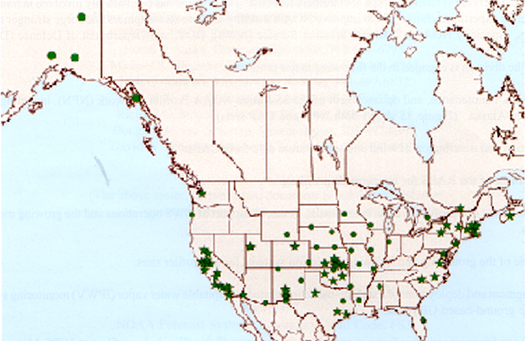
Figure 35. Location of all 35 NOAA Profiler Network sites and Cooperative Agency Profiler (CAP) sites that provide data via the Profiler Website.
The division comprises five branches organizationally; however, the branches work in a fully integrated team mode in supporting the overall objectives
of the division.
Network Operations Branch – Monitors systems’ health and data quality, and coordinates all field repair and maintenance activities.
Engineering and Field Support Branch – Provides high-level field repair, coordinates all network logistical support, and designs and
deploys engineering system upgrades. The branch also redeploys any GPS or profiler systems as needed.
Software Development and Web Services Branch – Provides software support of existing systems, develops new software and database
systems as needed, provides Web support of the division's extensive Web activities, and designs software to support a national deployment of profilers.
GPS-Met Observing Systems Branch – Supports development and deployment of the GPS-IPWV Demonstration Network, and provides
software development and scientific support.
Facilities Management and Systems Administration Branch – Manages all computers, data communications, network, and computer facilities
used by the staff and projects of the division.
Network Operations Branch
Douglas W. van de Kamp, Chief
Objectives
The Network Operations Branch is responsible for all aspects of NOAA Profiler Network (NPN) operations and monitoring, including the coordination
of logistics associated with operating a network of 35 radars and surface instruments (Figure 36). The original concept for an operational profiler network
envisioned the Doppler radar profiler as part of an integrated upper-air remote sensing system capable of measuring winds, temperature, and humidity.
The Demonstration Division’s progress toward these goals include the addition of the Radio Acoustic Sounding Systems (RASS) for temperature profiling
in the lower troposphere at 11 NPN sites, and GPS integrated precipitable water vapor (GPS-IPWV) systems for moisture measurements at all NPN sites.
In addition to the 35 NPN sites, another 175 NOAA and other-agency sites are monitored for timely GPS positions and surface observations to produce
real-time IPWV measurements. Additional wind and RASS data have been acquired from a growing number of independently operated profiler sites, now
totalling about 60. These Cooperative Agency Profilers (CAPs) include many lower tropospheric boundary layer profiler sites plus a few higher power
profilers similar to NPN sites. The data from these CAP sites are now being made available to the meteorological community in real time via the division’s
Webpage. Along with the four other branches within the division, this branch maintains and improves the NPN and BLP real-time data availability to the
National Weather Service (NWS) and other worldwide users. The Network Operations Branch directly supports NOAA’s mission of improving weather
products and services by providing real-time comprehensive, high quality upper-air and surface observations to NWS forecasters and numerical weather
prediction models.
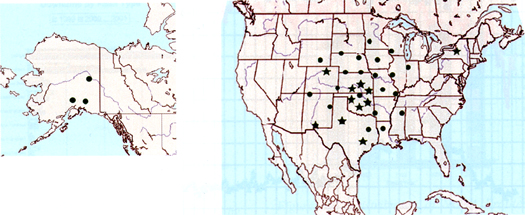
Figure 36. The NOAA Profiler Network of 35 radars and surface instruments. The Alaska sites are shown at the left. Circles show location of
NPN sites;
stars show location of NPN sites with RASS.
Accomplishments
The availability of hourly NPN winds to the NWS remained high through 2001, averaging about 95%. A summary of the overall performance of the
network for the past 11 years is presented in Figure 37. It is interesting to note the general pattern of decreased availability of hourly winds each year
during the spring and summer months, compared to slightly higher availability during the fall and winter months. This pattern has been analyzed and
is attributed to increased lightning activity and severe weather during the convective season (cause of more commercial power and communications problems),
along with profiler hardware damage from nearby lightning strikes and site air conditioner failures during the summer. From this trend analysis, additional
lightning suppression and communications equipment protection are being added to the profiler sites by the Demonstration Division’s Engineering and Field
Support Branch.
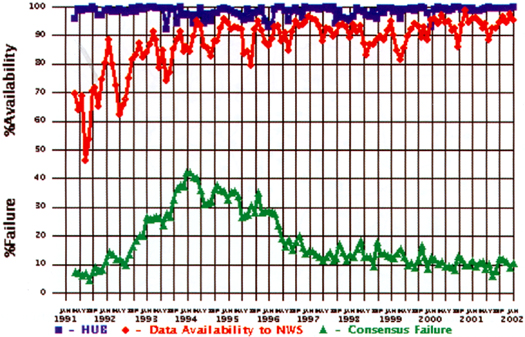
Figure 37. NOAA Profiler Network 404-MHz profiler data availability from January 1991 – January 2002.
A significant portion of personnel time involves the day-to-day operations and monitoring tasks related to the hardware, communications, and meteorological
data quality aspects of the NPN, resulting in the high data availability rates for the past few years. Other tasks include initial diagnosis of equipment failures,
coordination of all field repairs and maintenance activities, and maintenace of logs of all significant faults that cause an outage of profiler data. Figure 38 shows
the total number of hours of profiler data lost by fault type (such as component failures, scheduled downtime for maintenance, and power and air conditioner
failures) for the past three fiscal years. The duration of each data outage is broken down into many different states, including how long it took to identify a failure,
diagnose and evaluate the problem, wait for repair parts to be sent and received, restore commercial power or communications, and document when and how the
fault was ultimately repaired. Figure 39 shows the distribution of these categories of downtime (normalized over the past five years). Analysis of all these states
reveals important information regarding operation of the network, and was discussed in detail in last year’s annual report. In addition to the data monitoring
tasks, there are the financial aspects related to the continued operation of the NPN, including tracking land leases, communications, and commercial power bills
for the profiler sites.
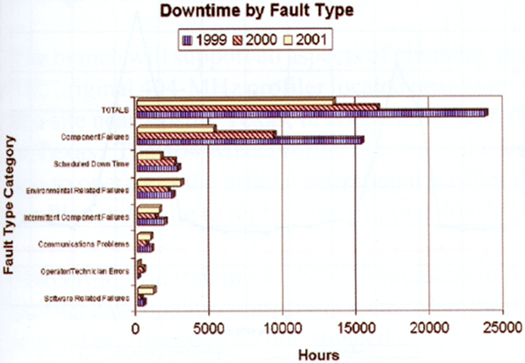
Figure 38. NOAA Profiler Network data lost by fault type for the
past three fiscal years.
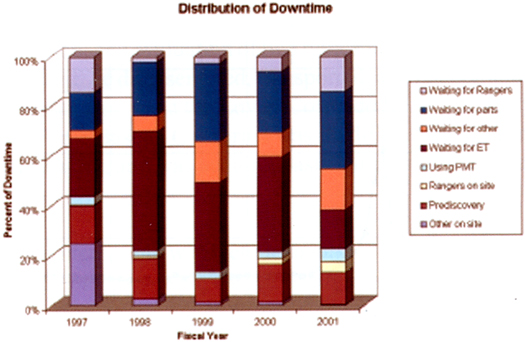
Figure 39. Distribution of NOAA Profiler Network downtime by categories (normalized over five years from 1997 – 2001).
Personnel in the Profiler Control Center (PCC) routinely monitor the NPN, currently noncommissioned by the NWS, only during normal working hours,
8:00 AM – 5:00 PM local time (27% of the total hours in a week). The remainder of the time, the profilers, dedicated communication lines, and Profiler
Hub computer system operate unattended. The division has made significant improvements in its ability to remotely monitor activity within the NPN, Hub
processing, and data communications via displays available on the Web and other tools. Activities that are now routinely monitored on the Web include
information on profiler real-time status, data flow to the NWS Telecommunications Gateway (NWSTG), and ingest of profiler data into the Rapid Update
Cycle (RUC) model at the NWS National Centers for Environmental Prediction (NCEP). These tools are used to remotely diagnose problems as they arise
outside of normal work hours and have increased the availability of NPN data.
Examination of several years of data showed that a significant number of lost hours of data were attributed to the local main power breaker (200 amp) being
tripped to the off position, usually caused by lightning related power surges. Simply resetting the breaker would restore operation, but still required a site visit.
From this analysis, the Engineering and Field Support Branch designed and installed the capability to remotely reset the main breaker via a phone call to the site.
This marked the first full year of the availablity of this capability. The Network Operations Branch routinely uses this method to restore profiler operations, as
well as "power cycling" a site in an attempt to clear software "hangs" and other problems. The breaker reset capability was activated 108 times outside normal
work hours to restore operations. It was successful 68 times (63% of the time), resulting in an additional 1,310 hours of profiler and GPS-IPWV data availability
to profiler customers. These resets performed outside normal work hours alone increased data availability by 0.4%.
Staff investigated the time (in minutes) at which the hourly averaged NPN data became available following processing by the Profiler Hub, and when the data
became available to NWS forecasters across the country and at NCEP. The results (Figure 40) show that the NPN data became available on the Hub at an
average time of 14 minutes past the hour. The profiler data (plotted in red) are available as early as 10 minutes past the hour, given no communications problems
with the incoming 6-minute data from all NPN sites. If there are any communications problems, the Hub waits for backup data to become available from the
GOES link; this can delay data availability to as much as 17 minutes past the hour (when waiting for the latest GOES minute used in the NPN). The NWSTG
automatically picks up these data from the Hub, and then queues them for transmission to all NWS offices and FSL. Branch staff monitored when the profiler
data (plotted in green) were received back at FSL via the NWS NOAAPORT. Inherent communications delays were found to add a minimum of 4 minutes to
the return receipt time of the data (evidenced by the first returned data becoming available at 14 minutes after the hour). The two unique spikes in each plot
(hourly data available from the Hub at 11 and 16 minutes after the hour) are reproduced (and smoothed by independent communications delays) with a
4-minute delay in the NWS return receipt times (visible at 15 and 20 minutes after the hour). It is interesting to note the much longer delays of 30 to
60+ minutes at times. These delays (Figure 41) show the mean times of NPN data availability (in minutes past the hour) plotted as a function of the hour of the
day. It can be seen that following completion of Hub processing (the nearly constant line at 14 minutes after the hour), NPN data are generally available to
NWS offices within 6 to 7 minutes, except for two time periods each day. These two periods of significant delays, separated by 12 hours and centered around
0500 and 1700 UTC, are apparently due to the transmission of numerical model output data to all NWS offices, saturating the NWSTG. Since the NPN is
currently a noncommissioned system, its data are given lower priority and queued for later transmission. After discussions with NWS, these delays have
been reduced, but significant delays still exist at times.
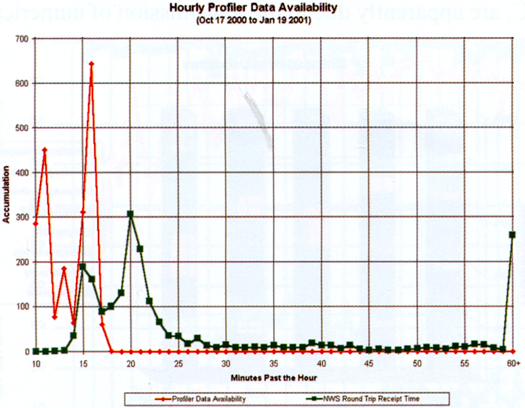
Figure 40. Hourly NOAA Profiler Network data availability,
from 17 October 2000 – 19 January 2001.
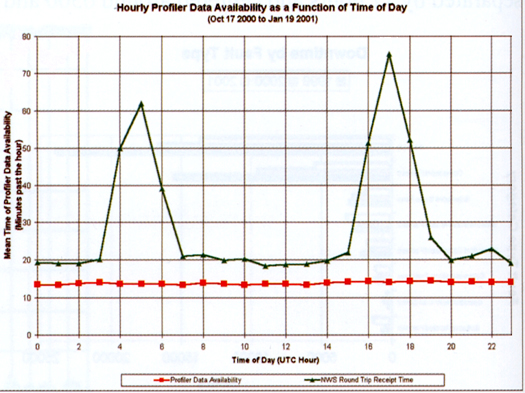
Figure 41. Hourly profiler data availability as a function of time of day,
from 17 October 2000 – 19 January 2001.
Two additional NPN sites (Neodesha, Kansas, and Jayton, Texas) were equipped with RASS for temperature profiling this past year. Eleven NPN sites now
have RASS capabilities, typically providing measurements up to 2.5 – 4 km above the ground. In general, the velocity of the lower tropospheric wind limits
the maximum height coverage of RASS by advecting the acoustic signal outside the radar beam. Each RASS-equipped site has four acoustic sources that
are located inside the antenna field fence near the corners of the wind profiler antenna. Ongoing experiments are being conducted at Platteville, Colorado,
and Purcell, Oklahoma, to investigate the impact of acoustic sources placed 35 – 140 m upwind of the profiler sites. Typical improvements of
500 – 1000 m in the RASS height coverage are observed when the 70 – 140 m upwind acoustic sources are activated. Prior to the latest RASS
installations at Neodesha and Jayton, tests were conducted with the acoustic sources located (approximately 30 m from the profiler antenna) in the far corners
of the profiler site’s acre of land. No consistent improvements in RASS height coverage were observed; therefore the sources were placed in their normal
configuration within the fence. Investigation continues concerning the optimum acoustic source location (distance upwind) and acoustic output power.
Low-power profilers that measure winds and temperature in the boundary layer to the lower troposphere (60 m to ~3 km above ground) have begun operating
in greater numbers around North America in recent years. They primarily support air quality measurements and meteorological research programs, and
typically operate independently or in small groups. Approximately 60 CAPs are currently operating and providing data to the Profiler Control Center in
Boulder. The division is working in cooperation with other agencies to acquire BLP wind and temperature data that are processed into hourly and subhourly
quality-controlled products, and are ultimately distributed along with products from the NPN. CAPs data are used for air quality monitoring and research,
and have application to numerical weather prediction and subjective weather forecasting in support of NOAA’s mission. The use of CAPs data from the
Profiler Website was mentioned for the first time ever in an Area Forecast discussion from the NWS Wakefield, Virginia, office during a high wind event in
December 2001.
A new data quality control algorithm was investigated and designed, and the specifications were sent to the Software Development and Web Services Branch
for implementation. The algorithm detects and identifies RASS temperatures and radial velocity data contaminated by internal interference.
The division received 11 DEC (now Compaq) Alpha computers this past year that will be used to replace aging MicroVAXs at profiler sites. The Network
Operations Branch participated in testing and validating the new systems. These systems could lend themselves to acquiring raw Doppler spectra, which
will lead to improved data quality related to reduced ground clutter and internal interference, and enhance existing bird detection software.
The impact of ground clutter can be minimized using both software processing and hardware modifications. An expert in ground clutter suppression with
NWS radars completed an initial analysis from a limited spectral dataset, and investigated the antenna structure height to fence geometry. A decision was
made to increase the height of the security fence around the perimeter of the profiler site installed near Austin, Texas.
Projections
The Bird Contamination Check algorithm will be examined for possible additional improvements. The original algorithm analyzed only the hourly averaged
north and east beams to detect the broader spectral widths caused by migrating birds. Recently the spectral width from the vertical beam was incorporated
into the algorithm. The next significant improvement is likely to involve more sophisticated processing of the 6-minute moment data.
The division will continue to operate and maintain the 11 RASS-equipped profiler sites. Experiments will continue at Platteville and Purcell to investigate the
optimum acoustic source locations (distance upwind) and acoustic output power. Improvements are expected in the quality control of RASS data, primarily
during periods of internal interference, and in the presentation (i.e., contouring specific temperatures) of RASS data on the Profiler Webpage.
The CAP Hub will continue to be operated and used to acquire additional tropospheric profiler data from targets of opportunity, provide quality control for
these data, and distribute that data to users via the Web and the NWSTG. Support will be provided to the Northeast Temperature and Air Quality Forecasting
Pilot Program. Work is underway to acquire CAP data from a newly installed 25-station network operated by the Japanese Meteorological Agency.
The branch will support all aspects of planning, installation, activation, and evaluation of two relocated NPN profilers. The original 404-MHz profiler located
near Platteville, Colorado, will be disassembled, transported, and reassembled at a site near Austin, Texas, in cooperation with the NWS Southern Region and
the Lower Colorado River Authority in Texas. The 404-MHz profiler located at the Vandenberg Air Force Base in California was modified several years ago to
operate at the official operational profiler frequency of 449 MHz, and was acquired last year for installation at the Platteville site to replace the original
404-MHz profiler.
Meteorological training for NWS forecasters in Alaska will be conducted, and will include theory of operation, use of profiler data, quality control issues, etc.
Also, the possibility of developing an NWS COMET teletraining module related to wind profilers will be investigated.
Continued collaboration with others in the division to support the operations and maintenance of the NPN will help to maintain consistently high data
availability statistics. This ultimately supports NOAA’s mission of improving weather products and services, resulting in reduced loss of life and property
damage from weather related events.
Return to Top of Demonstration Division Section
Engineering and Field Support Branch
Michael K. Shanahan, Chief
Objectives
The primary focus of the Engineering and Field Support Branch is to carry out the operation, maintenance, and improvement of the NOAA Profiler
Network (NPN). Through collaboration with the Profiler Control Center (PCC) at FSL, the 35-site network is monitored to assure data quality and
reliability. Constant network upgrades, identification of network problems (using remote diagnostics analysis), and prompt corrective actions result in
increased data availability.
In accordance with network maintenance agreements, the National Weather Service (NWS) Electronics Technicians do most of the preventive and
remedial maintenance. The PCC uses the remote diagnostics capabilities to recognize failed components, order Line Replaceable Units (LRUs), and
coordinate with the NWS electronics technicians regarding field repairs. More complex problems are handled by a team of specialized engineer/technicians,
called Rangers, who are experienced in the design and operation of the profiler systems. Based in Boulder, the Rangers can be mobilized to the field on short
notice to repair the profilers.
Accomplishments
Alaska Profiler Network – Experiments were performed to find a solution to the ground clutter problems affecting the profiler at Central, Alaska.
A temporary clutter fence was erected, and then extended 4 feet vertically. This provided a small but noticeable reduction in the clutter, and data quality
improved slightly. (Figure 42 shows data availability from January 2000 – March 2002 at the 449-MHz Alaska Profiler Network.) A more permanent
fence will need to be constructed at the site to withstand the snow loading and wind forces.
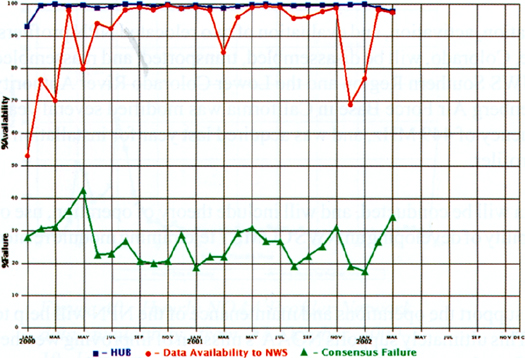
Figure 42. Data availability from January 2000 – March 2002 at the 449-MHz profiler network in Alaska.
The 449-MHz power amplifier and antenna documentation and drawings were distributed to the Alaska NWS offices. All the spare parts to support the
449-MHz profiler network in Alaska were delivered and stocked at the National Logistics and Support Center in Kansas City, Missouri. With a new
449-MHz test bed, both 404-MHz and 449-MHZ profiler equipment can be tested and repaired on site.
Other NPN Sites – Profiler sites at Neodesha, Kansas, and Jayton, Texas, were equipped with Radio Acoustic Sounding Systems (RASS), bringing
11 of the 35 profiler sites configured with RASS.
The Vandenberg Air Force Base 449-MHz profiler (Figure 43) was moved to Platteville, Colorado, for installation in 2002. It will be used to test the functional
requirements for a national network.
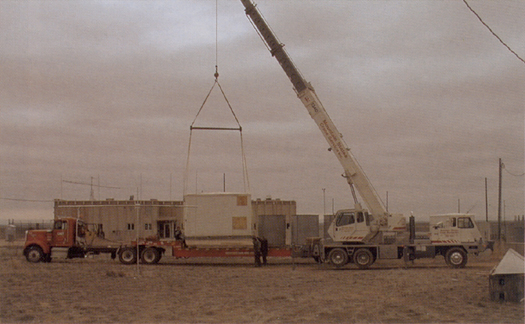
Figure 43. Profiler shelter arriving at Platteville, Colorado, from Vandenberg AFB. This site will be used as a test bed for a national 449-MHz profiler network.
The Engineering and Field Support Branch designed a new digital surface meteorological instrument, the Profiler Surface Observing System II (PSOS II) to
replace the current PSOS and GSOS (GPS Surface Observing System) instruments. Featuring a 10-meter mast with an anemometer and a rain gauge, the
PSOS II is capable of measuring surface air temperature, relative humidity, precipitation, barometric pressure and wind speed and direction. The Rangers
helped install 17 GSOS units.
Implementation of a newly designed grounding and lightning protection plan will continue, and all profiler sites will be tested and upgraded to meet the
design specifications. Additional lightning and surge protection will be installed at the sites to safeguard the sensitive communications from damage.
The 404-MHz RF drivers were reconfigured to eliminate the dependence on obsolete components. Eleven new data processors were accepted, and will boost
the current number of spare data processors.
Projections
A 404-MHz profiler complete with RASS, PSOS II, and GPS will be installed in the Austin, Texas, area in support of the NWS Southern Region and the
growing Texas Mesonet. The Platteville, Colorado, profiler will be moved to Austin, and the 449-MHz profiler from Vandenberg AFB will resume operation
at the Platteville location.
The grounding at wind profiler sites will be tested and modified from the current configuration to meet new design specifications. A uniform and organized
grounding scheme for current and future electronics will be provided, and transient voltage and surge protection for all RS-232 communications will be added.
An all-digital surface meteorological sensor package (PSOS II) will be installed to replace the GSOS units currently operating at some profiler sites. This will
be the first step toward providing uniformity among the 35 profiler sites and adding more surface meteorological data.
More experiments will be conducted to help reduce the amount of clutter that affects certain profiler sites in Alaska and the central U.S. Training will be
provided to the Electronic Technicians in the Alaska region.
Return to Top of Demonstration Division Section
Software Development and Web Services Branch
Alan E. Pihlak, Chief
Objectives
The Software Development and Web Services Branch is responsible for providing software support for existing systems, developing new software and
database systems as needed, providing Web support for the division’s extensive Web activities, and designing software to support a national deployment
of profilers. A current priority involves improving the NPN Website, http://profiler.noaa.gov, so that it is the first
place to go for wind profiler data.
Another focus is improvement of the timeliness of profiler data delivery and distribution, through work on existing software systems and development of
new software. The Profiler Website provides historical archives of wind, temperature, and other profiler information beneficial to researchers for forecasting
and modeling both long-term and short-term climate change. (Figure 44 shows a sequence of screen shots from the main NPN Website of the installation
of the profiler at the Ledbetter, Texas, site.)
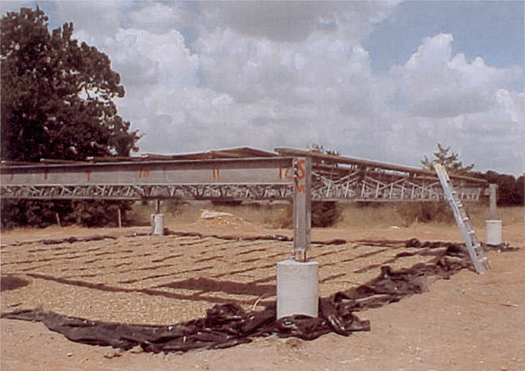
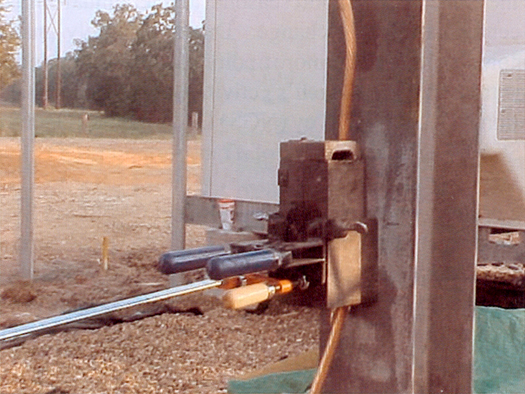
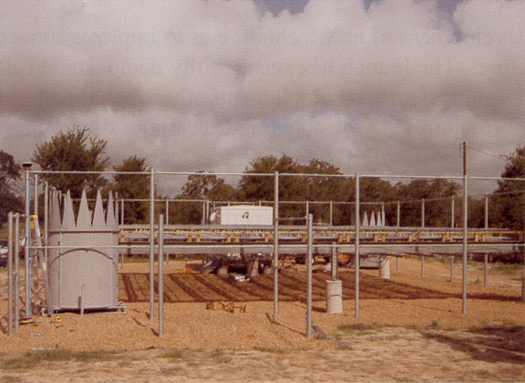
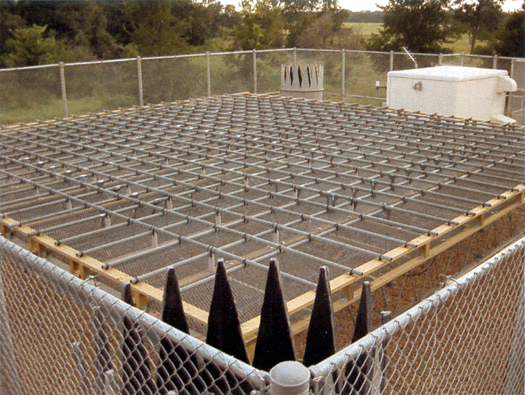
Figure 44. Photos showing some phases during construction of the profiler at Ledbetter, Texas. a) top figure, antenna support in progress,
b) second from top, radar weld finished, c) third from top, antenna and RASS (crown-like structures) in place and fence being installed, and
d) bottom, completed profiler. The NPN Website http://profiler.noaa.gov shows every sequence of construction
at this profiler site.
Accomplishments
During the last year the NPN Website was completely "overhauled," with improvements to the look and feel of the pages and in compliance with Section
508 guidelines. The Linux operating system and new hardware were acquired to improve the service level and to meet future capacity predictions. Web
software was ported from legacy systems to these new systems and upgraded. Data from all profilers operated by the NPN as well as profilers operated by
cooperative agencies were made available to the public via the Profiler Webpages. Division Web servers provided access to an average of 126 pages per day.
Significant progress was made on development of a software "toolkit" (using the Java language) consisting of low-level, reusable, independent software building
blocks that can be assembled quickly into larger systems. Many of these components have been used in completing the first phase of the project to improve
delivery of data to the NWS and NCEP. These data are now arriving an average of 6 minutes faster each hour than before, when data would occasionally arrive
too late to be used in the NCEP numerical weather models. This was accomplished by changing the format of the data sent to NWS from conglomerate to
individual per-station messages. GPS precipitable water vapor measurements are also being delivered to the NWS twice each hour.
Significant progress progress has been achieved in development of the Wind Profiler Processing Platform. The standard hardware and software configuration
of these systems was determined. Software central to the platform was developed and is in use in the production environment.
The number of Boundary layer profilers (BLPs) that measure up to 5 kilometers of the lower atmosphere is increasing each year. For example, at the
beginning of 2001 there were about 12 BLPs processed, and about 40 at the end of the year.
Projections
The division Website should have a minimum of one year’s data from NPN and BLP profilers online and available for downloading or viewing during 2002.
The first field-operational Wind Profiler Processing Platform (WPPP) prototype will be installed at a local profiler. It will support a new high-data-rate GOES
transmitter and emulate the old GOES transmitter to the profiler. It will provide a Web-based Portable Maintenance Terminal (PMT) interface for local or
remote operation of the profiler. The SARSAT (Search and Rescue Satellite-Aided Tracking System) schedule delivery, verification, and maintenance will
be supported. Hourly quality-controlled winds will be processed on the WPPP and distributed directly to the local WFO Local Data Acquisiition and
Dissemination (LDAD) system, and indirectly to other consumers. Another task that will be finalized is development of new, reusable graphics software
for displaying winds, temperatures, and moments from either the Web or local or remote datasets.
Return to Top of Demonstration Division Section
GPS-Met Observing Systems Branch
Seth I. Gutman, Chief
Objectives
The GPS-Met Observing Systems Branch was formed in response to the need for improved moisture observations to support weather forecasting,
climate monitoring, and research within NOAA. The activities of the branch primarily support NOAA’s environmental assessment and prediction
mission. It creates and disseminates reliable assessments of weather, climate, the space environment and geodetic phenomena using a new upper-air
observing system technique in support of advance short-term warning and forecast services. The data and techniques developed and implemented
by the branch also support seasonal to interannual climate forecasts as well as the prediction and assessment of decadal to centennial climate change.
Due to a largely unanticipated synergy between the requirements for atmospheric remote sensing and the more traditional applications of the Global
Positioning System (i.e., positioning, navigation, and time transfer), the branch’s activities also promote safe navigation by providing GPS and other
observations to the National Geodetic Survey (NGS) Continuously Operating Reference Station (CORS) network, the U.S. Coast Guard (USCG),
U.S. Department of Transportation (DOT), and other GPS users in the public and private sectors.
The primary objectives of the GPS-Met Observing Systems Branch are to define and demonstrate the major aspects of an operational ground-based
Global Positioning System (GPS) integrated precipitable water vapor (IPWV) monitoring system, facilitate assessments of the impact of GPS
meteorological data on weather forecasts, assist in the transition of GPS-Met data acquisition and data processing techniques to operational use, and
encourage the use of GPS in atmospheric research and other applications. The work utilizes the resources and infrastructure established to operate and
maintain the NOAA Profiler Network (NPN) in achieving these objectives at low cost and risk. The branch collaborates with other FSL divisions
(especially the Forecast Research Division, Aviation Division, International Division, Systems Development Division, and the Director’s Office which
includes the Information and Technology Services group) to achieve objectives of mutual interest and benefit the laboratory, its customers, partners,
and stakeholders.
This work represents an investment in scientific research, the development of new technologies to improve current operations, and assistance in
helping NOAA prepare for the future. The branch has successfully demonstrated all major elements of a reliable, low-cost, continuous upper-air
observing system that complements other operational and future ground- and space-based observing systems. New information network tools
and techniques have been adapted to acquire and process GPS and surface meteorological data from NOAA and other public private and international
partnerships. This capability has permitted rapid expansion of GPS-Met coverage at extremely low cost. The branch has been heavily involved in
developing and implementing environmental expertise and technologies to improve NOAA’s ability to serve its customers and forge stronger ties
with its partners, especially the National Weather Service (NWS), Department of Transportation (DOT), and Department of Defense (DOD).
Accomplishments
The development and implementation of real-time data processing techniques last year is a hard act to follow. Seen in context, it formed the basis of this
and all future years’ operational GPS-Met activities. In 2001, the branch concentrated on expanding the GPS-Met demonstration network, improving
data quality and availability to forecasters and modelers, enhancing the display of data and products, and supporting scientific research. Continued
support was also provided for ongoing assessment of the impact that GPS-Met data has on weather forecast accuracy.
Expansion of the GPS-Met Demonstration Network
The addition of 22 sites to the GPS-Met Demonstration Network brought the size of the network to 76 stations, an increase of about 36% (Figure 45).
The main reason for this growth during 2001 was the implementation of an agreement with the DOT that permits FSL to acquire GPS Surface
Observing System (GSOS) sensor packages from the NWS National Data Buoy Center (NDBC) and install them at all DOT NDGPS sites throughout
the United States. Seventeen NDGPS sites received GSOS packages last year, bringing the total number of NDGPS sites in the demonstration network
to 21. When the DOT project started in 1997, the first NDGPS site to be built was located at Appleton, Washington (Figure 46). At the lower right corner
of the picture is Mt. Hood in the Cascade Range. (One of the benefits of working on the GPS-Met project is being able to visit sites like this.)
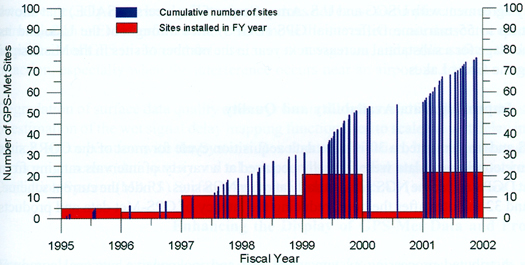
Figure 45. A chart showing 8 years of the growth of the GPS-Met Demonstration Network. The addition of 22 sites last year brought the size of the
network
to 76 stations, an increase of about 36%.
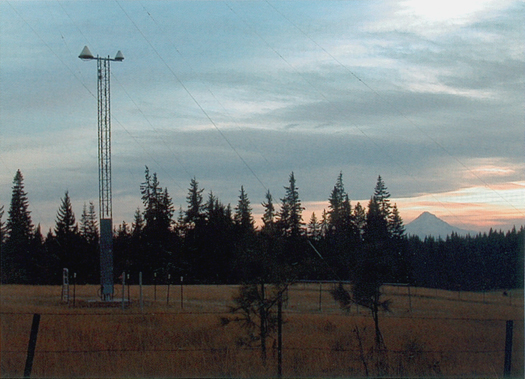
Figure 46. Photo of the Department of Transportation NDGPS site in Appleton, Washington. Mt. Hood is seen on the right side.
In addition to the 17 NDGPS sites, 5 other GPS-Met sites were added to the network:
- The NPN site near Neodesha, Kansas, was moved and reestablished.
- The CORS site at the U.S. Naval Observatory (USNO) in Washington, D.C., which will also be used to improve USNO time transfer.
- A NASA site on the Chesapeake Light Ocean Platform, Virginia, which will also be used to calibrate and validate Advanced Infrared Sounder
(AIRS) data from the Aqua (EOS-PM) Spacecraft in 2002.
- A tide monitoring site belonging to NGS at Bar Harbor, Maine.
- A DGPS site in the City of Grand Junction, Colorado, belonging to the Mesa County Colorado DOT for surveying, 911 response, and infrastructure
support. This site is the first nonfederal government site incorporated into the GPS-Met network, and paves the way for expanded cooperation with
state and local government agencies in the future.
In 2001, FSL signed an interagency agreement with USCG and U.S. Army Corps of Engineers (USACE) that allows FSL to install GSOS packages at
up to 55 maritime Differential GPS (DGPS) sites throughout the U.S. and its Territories. This agreement sets the stage for a substantial increase next year
in the number of sites in the Mississippi and Ohio River Valleys, and along the Great Lakes.
Improving Data Availability and Quality
The branch collaborated with NGS and implemented a 30-minute data acquisition cycle for most of the CORS sites in the network. GPS and surface
meteorological data were formally acquired at a variety of intervals ranging from 30 minutes at NPN sites to hourly at DGPS and some NGS sites, to
daily at other NGS sites. Under the current scheme, data are acquired at two minutes and 32 minutes after the hour, reducing the latency of GPS-Met data
and products to modelers and forecasters.
The branch developed a scalable distributed processing system using fast and inexpensive personal computer workstations running the Linux
operating system. The basic architecture was validated this year, and some minor improvements were implemented to improve performance. In
general, processor speed continued to increase in 2001 as prices fell, resulting in a significant improvement in network performance, throughput and
cost effectiveness.
The entire Demonstration Division is cooperating with the NWS Telecommunications Gateway and the National Centers for Environmental Prediction
(NCEP) to make GPS-Met and boundary layer profiler (BLP) data available to models and forecasters in real time. This work just began late last year,
and much progress is expected in the coming year.
GPS-Met has three basic quality issues: orbit accuracy, zenith tropospheric delay (ZTD) estimation accuracy, and surface data accuracy. Orbit accuracy
is determined by comparing calculated or predicted GPS satellite orbits with International Geodetic Service (IGS) final orbits. The GPS-Met project currently
uses 2-hour predictions derived from Scripps Orbit and Permanent Array Center (SOPAC) hourly orbits. SOPAC produces these orbits with 1-hour latency,
and provides the orbital parameters to the project for use in real-time data processing. SOPAC hourly orbit predictions have a mean error of less than 20 cm
at the 2 sigma level with respect to the IGS final orbits. However, since the orbits are calculated from data supplied to SOPAC by a subset of the IGS global
tracking network, and problems sometimes occur acquiring or processing these observations, predictions longer than 2 hours with uncertain impact on ZTD
estimation accuracy may have to be used. In general, orbit errors introduce a slow degradation of ZTD accuracy and are difficult to detect. The branch
asked SOPAC to investigate techniques to perform on-the-fly quality control, at least to provide an orbit quality flag for use in data processing. Unfortunately,
all techniques investigated proved to be unreliable, and so the branch has implemented two levels of qualitative protection. The first involves notification
that hourly orbit delivery has stopped and the orbits are more than three hours old. The second involves comparing the RMS scatter in the ZTD estimates
(commonly referred to as the ZTD Formal Error or FERR) of stations very far apart. It was found that FERR generally increases as orbit quality degrades,
and that if the FERR of stations very far apart (and at widely spaced magnetic latitudes) are highly correlated, then a bad orbit is usually responsible.
On occasion, ZTD accuracy at a site can degrade dramatically in a short period of time. This can be caused by data gaps that are usually associated with
equipment malfunctions or communications interruptions, and electromagnetic (EM) interference. Detecting the former is usually straightforward, and
is accomplished with high reliability by automatic monitoring of the data acquisition/data processing cycle. Errors caused by the latter are much harder
to detect, especially if the level of interference does not cause a complete loss of data continuity. In fact, the only long-term solution to EM interference
may be to move the site or terminate the source of interference. In view of the growing importance of GPS in national defense, aircraft navigation, and
public safety, the latter may be the preferable course of action, especially when the interference occurs near an airport or sensitive facility.
Degradation of surface data quality causes errors in the retrieval of the hydrostatic signal delay from surface pressure, or estimation of the wet signal delay
mapping function used to scale the wet delay into its water vapor equivalent. The branch, in cooperation with the Systems Development Division, has
implemented methods to continuously monitor surface met sensor data quality and take as-required remedial action using a tool called the Mesoscale
Analysis and Prediction System (MAPS) Surface Analysis System or MSAS (see
http://www-sdd.fsl.noaa.gov/MSAS/qcms.html).
Enhancing the Display of GPS-Met Data and Products
The branch initiated a redevelopment of its Web page, http://gpsmet.noaa.gov, to improve the utility and availability
of GPS-Met data to operators, forecasters, and researchers. Improvements include a real-time data collection monitor, a virtual status board, a quick-look
option that shows seven days of data and products from all sensors at a site, and an interactive browser that permits the user to retrieve historical data as an
image or a text file.
Many forecasters looking at the GPS-Met data on the Web comment that it would be very useful to be able to view GPS data on meteorological workstations,
especially AWIPS. Clearly it would be useful to have map-view displays of the GPS-Met data and products to assist in subjective forecasting and facilitate
data fusion. The International Division agrees that FX-Net would be an ideal platform to prototype the look and feel of GPS-Met workstation displays and
functionality, and will begin to investigate ways to accomplish this in 2002.
Supporting Scientific Research
The GPS-Met Observing Systems Branch participated in two major scientific experiments, and began planning for two major field experiments in 2002.
As was done during the CALJET experiments in 1997 and 1998, the branch participated in the 2001 PACJET experiment led by the Environmental Technology
Laboratory. GPS-Met data were acquired, processed, and analyzed as part of a study to improve short-term forecasts of land-falling Pacific winter storms on
the U.S. West Coast. Results from CALJET and PACJET 2001 are now appearing in conference and journal articles, and the lessons learned are being applied
to the 2002 field campaign, which will include an expanded network of GPS-Met sensors.
Support was also provided for an experiment conducted by the Aeronomy Laboratory to detect the presence of the hypothesized water Dimer, and describe
its attributes and distribution in the free atmosphere. GPS water vapor observations taken along a line from Boulder to Sterling, Colorado, provided an
important constraint on the data analysis. GPS-Met data comparisons at five sites along this line are presented in Figure 47.
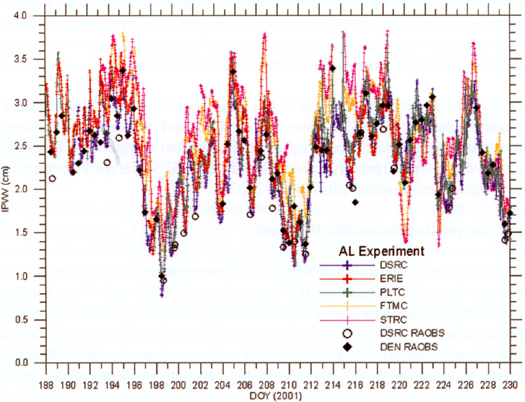
Figure 47. GPS-Met data comparisons of GPS water vapor observations taken along a line from Boulder to
Sterling, Colorado, during an Aeronomy Laboratory summer 2001 experiment to detect the presence of the
hypothesized water Dimer.
Finally, the branch submitted a successful joint proposal to the NASA Jet Propulsion Laboratory with the National Environmental Satellite, Data, and
Information Service (NESDIS) Office of Research and Applications. The project involves the use of data from the GPS-Met network to calibrate and
validate observations from the Atmospheric Infrared Sounder (AIRS) aboard the Aqua (formally EOS-PM) spacecraft, expected to be launched in April 2002.
Ongoing Assessment of the Impact of GPS-Met Data on
Weather Forecast Accuracy
Evaluations of the impact of GPS-IPWV observations on weather forecast accuracy have been conducted since 1997 within the Forecast Research Division.
Results from 2000 and 2001 show 3-hour relative humidity forecast improvement (Figure 48) achieved by assimilating GPS-Met data into the Rapid Update
Cycle (RUC). The difference between the two experiments was the number of sites in the assessment: 56 in 2000, and 67 in 2001. It shows the improvement
in 24-hour precipitation forecasts achieved by assimilating GPS-Met data into the RUC in 2000 and 2001. Improvement in forecast accuracy is defined in
terms of the Equitable Threat Score, Probability of Detection, and Bias.
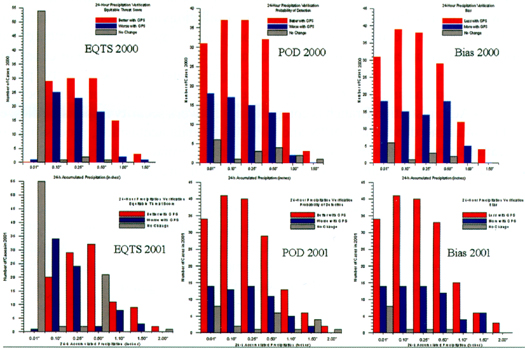
Figure 48. Graphs showing improvement in 24-hour precipitation forecasts achieved by assimilating GPS-Met data into the RUC in 2000 and 2001.
Improvement in forecast accuracy is defined in terms of the
Equitable Threat Score, Probability of Detection, and Bias.
Projections
GSOS is expected to be installed at about six new NDGPS sites during early 2002. Capitalizing on the signed agreement with the USCG and USACE last year,
plans are to also install approximately 22 GSOS at maritime DGPS sites along the West Coast, Great Lakes, and in the Mississippi and Ohio River Valleys.
The GPS-Met Observing Systems Branch is cooperating with NGS in a Center for Operational Oceanographic Products and Services (CO-OPS) program to
use GPS to monitor the levels of the Great Lakes and its tributaries. Other participants include the Ohio State University, NOS Office of Ocean and Coastal
Resource Management, NOS Office of the Coast Survey, OAR Great Lakes Environmental Research Laboratory, Canadian Hydrographic Service, and the
National Resources Canada Geodetic Survey Division. This project may provide an additional 22 sites to the network.
The branch has been involved in an informal outreach activity to educate many federal, state, and local government entities about GPS-Met, convince them
that it is in both their and NOAA’s interest to jointly use these data, identify GPS sites belonging to these agencies, and persuade them to make their data
available to FSL in near real time. Some of these efforts are progressing, but require a more formalized technical and programmatic outreach effort in order
to reach completion. These goals are being accomplished through cooperation with the FSL Aviation Division. In concert with this activity, the branch will
investigate ways of using only the tropospheric delays calculated at these sites, without the benefit of collocated surface meteorological sensors. GPS-Met
processing at these sites will be tightly coupled to data provided by nearby (but not collocated) surface met sensors, and numerical models for quality control
and bias corrections. To facilitate the incorporation and display of GPS-Met data on operational workstations, the branch will work with various FSL divisions
to use FX-Net to prototype GPS-Met workstation displays and functionality.
The branch will participate in three major experiments next year: IHOP, the New England High Resolution Temperature and Air Quality Forecasting Pilot
Program, and the Aqua AIRS CAL-Val. To increase the amount of GPS-Met data available to forecasters, modelers, and researchers, all available SuomiNet
data from UCAR will be acquired, processed, added to data from the Demonstration Network, and made available in real time to the teams conducting these
experiments.
Return to Top of Demonstration Division Section
Facilities and Systems Administration Branch
Bobby R. Kelley, Chief
Objectives
The objectives of the Facilities and Systems Administration Branch are to manage and support the Demonstration Division communications and
computer requirements. Duties include performing systems operations, systems maintenance, systems administration, network administration,
NOAA Profiler Network (NPN) telecommunications administration, and support of the Global Positioning System Integrated Precipitable Water
Vapor (GPS-IPWV) demonstration project. (Figure 49 shows a screen from the GPS-Met Demonstration Network main Webpage.) These responsibilities
continue to cover a broad range of computers and communications equipment.
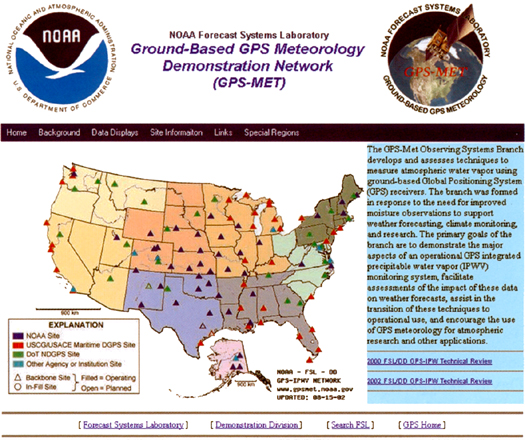
Figure 49. A screen capture of the GPS-Met Demonstration Network
main
Webpage, http://www.gpsmet.noaa.gov/jsp/index.jsp.
Accomplishments
NPN processing continues to be accommodated on 13 micro-VAXs configured in two clusters, primary and backup. Meanwhile, a development environment
of networked PCs running Linux has been implemented to facilitate ongoing development of the modernized NPN processing system. Other data processing
and Webpage hosting are in the process of being moved from a Sun E3000 server to a PC-based server running the Linux operating system, and this transition
will be completed during 2002. GPS-IPWV processing has been moved to a network of PCs running the Linux operating system. Eighteen PCs running Linux
are used for GPS-IPWV data acquisition, processing, and distribution. The division’s file and e-mail server has been transferred to a PC-based server running
the Microsoft Windows 2000 advanced server, which provides connectivity to more than 30 PCs running Microsoft Windows 9x, NT 4, or 2000. An improved
backup file system was implemented to ensure rapid recovery in the event of system failures. Backup communications for NPN data acquisition continues to
be provided through an Intel 386-based PC running SCO Unix that is connected to a DOMSAT receiver. Work is ongoing to replace this system with a PC
running the Linux operating system and the new DOMSAT data acquisition software.
Telecommunications responsibilities cover 38 NPN data circuits within the lower 48 states and in Alaska. Day-to-day work continues to include new component
installations and systems configuration on the division network, network problem isolation and maintenance, system configuration modifications to meet division
requirements, system problem isolation and maintenance, in-house telecommunications maintenance or coordination for contracted maintenance, peripheral
installation and configuration, computer and network security, preventive maintenance, information technology purchasing, and routine file system backups.
Another primary focus of the Facilities Management and Systems Administration Branch is computer and network security responsibilities: ensuring system and
data integrity and maintaining dependable NPN and GPS-IPWV data acquisition, processing, and distribution. Full-time (24/7) operations coverage continues to
be provided during normal workdays through the Profiler Control Center in Boulder, and via pager during nights, weekends, and federal holidays.
Since an uninterruptable power system (UPS) was installed in the computer room and connected to the building emergency generator two years ago, maintenance
of electrical power for the NPN and GPS-IPWV processing systems during adverse conditions has become virtually worry-free. Maintaining necessary computer
room air conditioning is the next task at hand, and work to alleviate this shortcoming will be accomplished in 2002 with the installation of a stand-alone computer
room air conditioning unit.
The table below shows data acquisition, processing, and distribution statistics for the past two calendar years. Improvements that were made prior to and during
2000 were proven maintainable throughout 2001. Development of the modernized NPN processing system is targeted to meet and exceed these statistics.
|
|
Calendar
Year 2000
|
Calendar
Year 2001
|
|
Average Communications Systems Uptime
|
96.8%
|
96.5%
|
|
Average NPN Processing Systems Uptime
|
99.3%
|
99.6%
|
|
Average Data Delivery to NWS
|
94.4%
|
94.6%
|
Projections
Job one is ensuring continuous and dependable acquisition, processing, and distribution of NPN and GPS-IPWV data. Plans are to maintain current operations
and ensure continued timely data delivery to all customers. Further development, testing, and implementation of the modernized NPN processing system will
continue. Success continues to be realized with a low-cost, high-performance approach of using off-the-shelf PCs running the Linux operating system. A
stand-alone air conditioning unit is being installed in the computer room to help ensure NPN and GPS-IPWV data availability under adverse conditions or
situations that might result in downtime of the building cooling systems.
Return to Top of Demonstration Division Section
|

|





















